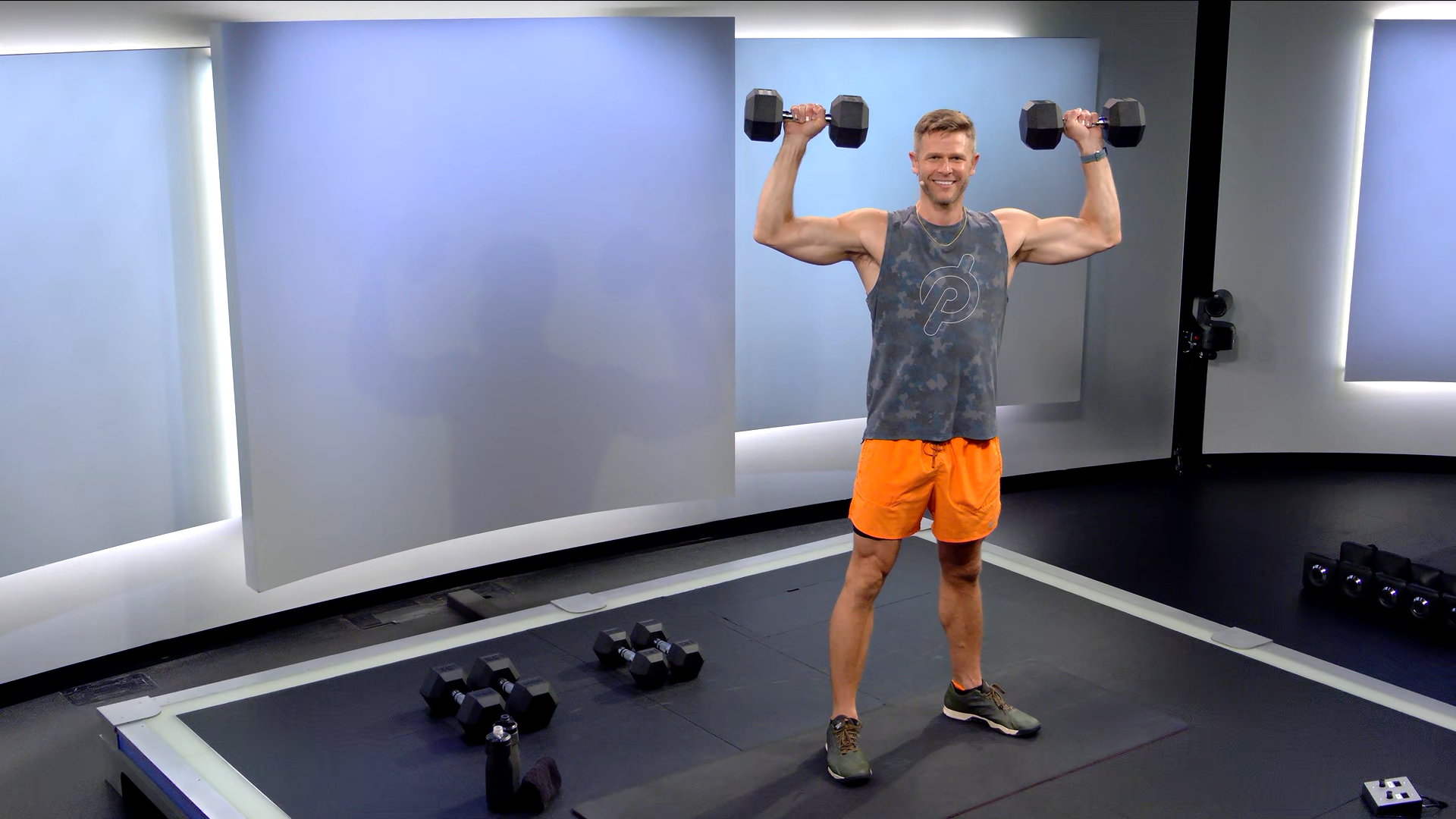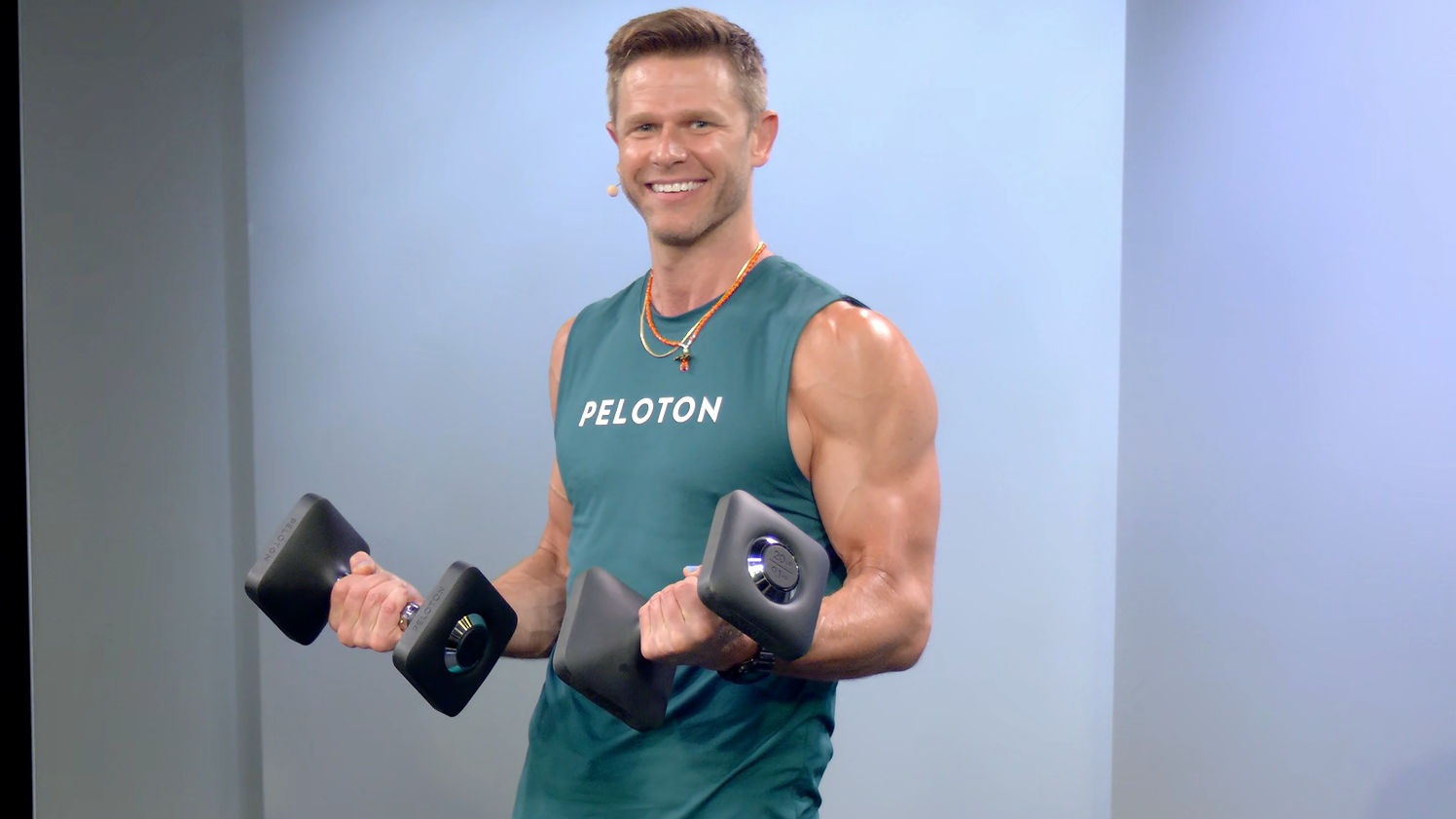
Grip Strength Isn’t Just For Pull-Ups—Here’s Why You Need It, Plus the Best Grip Strength Exercises to Try
Getting a handle on how you hold weights will make your workouts more effective.
By Colleen Travers, Peloton•
Why Is Grip Strength Important?
Types of Grip Strength
4 Everyday Exercises to Improve Your Grip Strength
4 Exercises to Improve Your Grip Strength During Your Workout
If you’re new to strength training with weights or you’ve mostly done bodyweight workouts before, you might overlook the importance of grip—but a solid grip is crucial for effective workouts. The firmness of your hold can influence fatigue onset during reps. As Peloton instructor Andy Speer notes, if your grip weakens before the main muscles you’re trying to work or if you struggle to keep dumbbells secure in your hands without overextending your wrists, it's time to enhance your grip technique.
In this article, we’ll explain the significance of grip strength and its various forms. Additionally, we'll provide insights on enhancing your grip strength, ensuring you maximize your workout's efficacy and boost your strength training endurance.
Why Is Grip Strength Important?
Grip strength is a measure of how tightly you can hold onto an object in your hand and how long you can firmly grasp it. Grip strength comes from your forearm muscles—so if you’ve ever leveled up your weights for non-forearm exercises (like deadlifts) and felt sore in your forearms the next time, you probably need to improve your grip strength. As for why you should want to improve grip strength, the metric is associated with tons of important health and well-being biomarkers.
Indicator of Muscular Strength
Grip strength is a general indicator of muscular strength and endurance (especially in the upper body), according to the Journal of Clinical and Diagnostic Research. This means that by assessing one's grip strength, we can gain insights into the health and functionality of larger muscle groups in the arms, shoulders, and chest.
Signs of Overall Health in Older Adults
Grip strength is also correlated with overall health in older adults, meaning it’s a sign that someone’s maintaining their physical functionality and independence as they age. A stronger grip is associated with a lower risk of cardiovascular disease and a stronger immune system. Additionally, it indicates a more robust immune system, which is crucial in warding off illnesses and ensuring faster recovery from health setbacks.
Connection with Cognitive Health
There’s also evidence to support the connection between grip strength and brain power, aka cognitive health. Even more compelling, research shows that better grip strength is associated with higher life satisfaction, greater subjective well-being, and reduced depression and anxiety symptoms. That’s pretty convincing, right?
Why all the connections between grip strength and your overall health? It all comes down to functional movements. Sure, grip strength is great for cranking out pull-ups or adding weight to your deadlift, but it’s essential for holding heavy groceries, opening jars on your own, and clasping your pickleball paddle during intense rallies. If you're unable to carry out these tasks on your own, it's likely that your overall well-being and life satisfaction could be negatively impacted.

Types of Grip Strength
Understanding grip strength goes beyond just how tightly you can hold something. In fact, grip strength is multifaceted, with each type serving a unique purpose in our daily activities. Let's explore the three distinct types of grip strength.
Crush
Think about forming a fist during rock, paper, scissors—that’s “crushing” it, literally. Other real-life examples include squeezing a stress ball, holding onto a barbell, or even crumpling junk mail before discarding it.
Pinch
This grip involves the force exerted between your fingers and thumb. Think of gently pinching a toddler's cheeks, (gently!) using a clothespin, or holding a bundle of damp workout clothes at arm's length.
Support
This is a more passive type of grip strength, but it’s hugely important. Support refers to your ability to grasp an item for an extended period of time, like when hanging from a pull-up bar for as long as possible or trying to carry your overpacked weekender bag through miles of airport terminals.
4 Everyday Exercises to Improve Your Grip Strength
If you’re not sure how to fit another workout into your already-packed schedule, don’t stress. Grip strength exercises can easily be added to the movements and activities you’re already doing. Many of these grip strength exercises can be done while multitasking, too—watching TV, reading an article for work, or under your desk during a Zoom meeting. These are the best grip strength exercises you can do at home, without any extra equipment.
1) Tennis Ball Squeezes
Grab an extra tennis ball (or even your dog’s favorite fetch ball, if that’s all you have) and lightly hold it in the palm of your hand. Your elbow should be bent at a 90-degree angle so your arm forms an L-shape. Using only your four fingers, squeeze the tennis ball as tightly as you can for five seconds, then release for five seconds. Repeat 10 times, then switch to your other hand. Over time, you can increase the length of your squeeze.
2) Paper Pinching
Take two stacks of loose papers off your desk (or a book, if you’re a stickler for neatness) and grasp them in between your thumb and your fingers, one in each hand. Pinch as tightly as you can for 30 seconds so that you don’t lose a single sheet, then rest for 30 seconds. Repeat five times. As you progress, go for heavier and heavier books—you’ll be up to War and Peace in no time. (And if you’re at the gym, you can do this exercise with a 10-pound weight plate in each hand.)
3) Towel Wrings
Grip a wet washcloth or hand towel with one end in each hand, roughly shoulder-width apart. Raise the towel to chest height and twist each end in opposite directions to wring the water out (sure, you could do this with a dry towel, but this is more satisfying). Add this to your nighttime routine after washing your face—boom, you’re taking self-care to a new level.
4) Rubber Band Reps
Take a rubber band or hair tie and slide it over your fingers and thumb on one hand, stopping when the band rests roughly around your middle knuckles. Spread your fingers and thumb far apart to push the rubber band as wide as you can and increase the tension. Slowly and with control, bring your digits back toward each other—and without releasing the tension fully, go straight into the next rep. Do 30 reps, then switch hands.

4 Exercises to Improve Your Grip Strength During Your Workout
For many of us, all we need to do to literally get a grip is to start—or continue to—strength train. “If you are regularly strength training, grip strength can develop naturally,” Andy says.
However, there is some targeted training you can do to get a stronger grip faster. In fact, standard gym equipment like barbells, dumbbells, and pull-up bars can help you improve your grip strength by leaps and bounds. Here, we explain several of the best grip strength exercises to do at the gym.
1) Farmer’s Carry
“Hold a pair of dumbbells and march in place,” Andy says. “If you have room to walk, you can do that. The goal is not to cover ground; it’s to hold the dumbbells for a certain amount of time, keeping proper posture with your body.”
Using the heaviest pair of dumbbells you can start with two or three sets lasting one to two minutes each. Do this two to three times a week, adding 10 to 15 seconds each week as you progress. After about a month, you’ll notice a significant shift in your grip. And if you get a few calluses, don’t panic—they’ll help protect your skin during future lifts.
2) Reverse Wrist Curls
Step aside, biceps curls—reverse wrist curls are here to improve your grip strength. Start with an overhand grip (palms facing down) on dumbbells or a barbell, whichever you’re more comfortable with. Rest your forearms on your knees, then pull the back of your hands toward your body to flip your palms up until they’re at a nearly 90-degree angle to your forearm. (Don’t worry, your forearms can rest on your legs for this entire move.) Aim for 3 sets of 10 reps to start.
3) Endurance Hang
Sometimes doing more means doing less—and that’s exactly how to improve your grip strength with a simple dead hang. This grip strength exercise is a type of isometric exercise since requires you to hold a static position.
Find a pull-up bar and stand directly underneath it (or on top of a box or bench if you’re on the short side). Raise your arms and place your hands slightly shoulder-width apart on the bar, palms facing away from your body. Get a good grip, remove any support you were standing on, and pretend you’re hanging on the edge of a cliff for as long as possible.
4) Wrist Rotations
There is such a thing as too strong of a grip. Gripping weights excessively tight can be just as detrimental to your form as not gripping them firmly enough. Andy suggests this routine to master the perfect grip: Using a light dumbbell (try five pounds to start), hold your arms out at 90 degrees (think about the halfway point in a hammer curl exercise). Rotate the palms up and down, tilting the dumbbells and flexing and extending your wrists. Do this until you start to feel fatigued.
Pro tip: If the weights you have at home are too heavy for the above exercise, use household items like water jugs, ropes, or even a towel to start. “You just want to work on keeping the wrist in a neutral position, so it doesn’t fall out of an extension or tilt your dumbbells side to side when doing a chest press,” Andy says. If done correctly, these items can have the same impact as free weights.
Ultimately, you want to do two to three sets of this move twice a week. It’s a great way to warm your hands up before a 10-minute strength class on the Peloton App. But if you feel like you can’t handle a strength training session on top of grip training but still want to get a workout in, opt for a bodyweight strength class instead to give your hands a break while still working your muscles.
Ready to get a grip? Add these Peloton-recommended grip strength exercises into your routine, and see how quickly you notice a difference—both in your workouts and in your everyday life.
Level up your inbox.
Subscribe for a weekly dose of fitness, plus the latest promos, launches, and events.